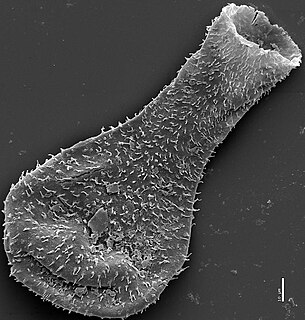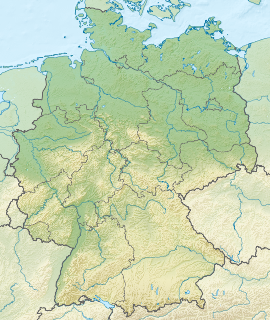Related Research Articles

Palynology is literally the "study of dust" or of "particles that are strewn". A classic palynologist analyses particulate samples collected from the air, from water, or from deposits including sediments of any age. The condition and identification of those particles, organic and inorganic, give the palynologist clues to the life, environment, and energetic conditions that produced them.

Chitinozoa are a taxon of flask-shaped, organic walled marine microfossils produced by an as yet unknown organism. Common from the Ordovician to Devonian periods, the millimetre-scale organisms are abundant in almost all types of marine sediment across the globe. This wide distribution, and their rapid pace of evolution, makes them valuable biostratigraphic markers.
Friedrich von Huene, full name Friedrich Richard von Hoinigen was a German paleontologist who renamed more dinosaurs in the early 20th century than anyone else in Europe. He also made key contributions about various Permo-Carboniferous limbed vertebrates.
Dinocysts or dinoflagellate cysts are typically 15 to 100 µm in diameter and produced by around 15–20% of living dinoflagellates as a dormant, zygotic stage of their lifecycle, which can accumulate in the sediments as microfossils. Organic-walled dinocysts are often resistant and made out of dinosporin. There are also calcareous dinoflagellate cysts and siliceous dinoflagellate cysts. Many books provide overviews on dinocysts.
Paleontology or palaeontology is the study of prehistoric life forms on Earth through the examination of plant and animal fossils. This includes the study of body fossils, tracks (ichnites), burrows, cast-off parts, fossilised feces (coprolites), palynomorphs and chemical residues. Because humans have encountered fossils for millennia, paleontology has a long history both before and after becoming formalized as a science. This article records significant discoveries and events related to paleontology that occurred or were published in the year 1967.

Apateon is an extinct genus of temnospondyl amphibian within the family Branchiosauridae.
Paleontology or palaeontology is the study of prehistoric life forms on Earth through the examination of plant and animal fossils. This includes the study of body fossils, tracks (ichnites), burrows, cast-off parts, fossilised feces (coprolites), palynomorphs and chemical residues. Because humans have encountered fossils for millennia, paleontology has a long history both before and after becoming formalized as a science. This article records significant discoveries and events related to paleontology that occurred or were published in the year 1893.
Helmstedtisuchus is an extinct genus of fish. Fossils have been found from Helmstedt, Germany that are late Eocene in age. The genus was originally thought to be a eusuchian crocodylomorph, but it is now known to have been a scombrid teleostean fish.
Eberhard Fraas was a German scientist, geologist and paleontologist. He worked as a curator at the Stuttgarter Naturaliensammlung and discovered the dinosaurs of the Tendaguru formation in then German East Africa. The dinosaur Efraasia is named after him.

The Solling Formation is a geologic formation in Germany. Formerly considered earliest Triassic (Induan), but later dating places the formation from the Olenekian to Anisian of the Triassic period.
Franz Heritsch was an Austrian geologist and paleontologist, known for his studies of the Paleozoic of the Eastern Alps.
Chirodella is an extinct genus of conodonts in the family Prioniodinidae.
Christian Ernst Weiss was a German mineralogist, geologist and palaeontologist. He is not to be confused with the historian Christian Ernst Weiße (1766–1832).
Conochitina is an extinct genus of chitinozoans.

The Posidonia Shale or Posidonienschiefer Formation is a geological formation of southwestern Germany, northern Switzerland, northwestern Austria, southeast Luxembourg and the Netherlands, that spans about 3 million years during the Early Jurassic period. It is known for its detailed fossils, especially sea fauna, listed below. Composed mostly by black shale, the formation is a Lagerstätte, where fossils show exceptional preservation, with a thickness that varies from about 1 m to about 40 m on the Rhine level, being on the main quarry at Holzmaden between 5 and 14 m. Some of the preserved material has been transformed into fossil hydrocarbon Jet, specially wood remains, used for jewelry. The exceptional preservation seen on the Posidonia Shale has been studied since the late 1800s, finding that a cocktail of chemical and environmental factors let to such an impressive conservation of the marine fauna. The most common theory is the changes on the oxygen level, where the different anoxic events of the Toarcian left oxygen-depleted bottom waters, with the biota dying and falling to the bottom without any predator able to eat the dead bodies.

The Ciechocinek Formation is a Jurassic geologic formation which extends across the Baltic coast from Grimmen, Germany, to Nida, Lithuania, with its major sequence in Poland and boreholes in Kaliningrad. Dinosaur species uncovered here, unclassified genus.

The Besano Formation is a geological formation in the southern Alps of northwestern Italy and southern Switzerland. This formation, a short but fossiliferous succession of dolomite and black shale, is famous for its preservation of Middle Triassic marine life including fish and aquatic reptiles. It is exposed in the vicinity of Monte San Giorgio and is among the formations responsible for the area being designated as a UNESCO World Heritage Site.
Bdellodus is an extinct genus of hybodont shark from the Early Jurassic epoch of the Jurassic Period. The name roughly translates to "Leech Tooth." Friedrich August von Quenstadt named them this due to their "coal-black" color which he associated with leeches. It is monotypic, containing only the species B. bollensis. It is known from the Toarcian of Germany. It was named on an associated dentition. It is often placed in the subfamily Acrodontinae alongside other durophagous hybodontids.
Karl A. Mädler was a German paleobotanist and palynologist.
References
- ↑ Gocht, H. Sarjeant, W. A. S. 1983. Pioneer in palynology: Alfred Eisenack (1891–1982). Micropaleontology, 29, 470-477.
- ↑ Gocht, H. Sarjeant, W. A. S. 1983. Pioneer in palynology: Alfred Eisenack (1891–1982). Micropaleontology, 29, 470-477.
- ↑ Sarjeant W.A. 2002. 'As chimney-sweepers, come to dust': a history of palynology to 1970. From: OLDROYD, D. R. (ed.) 2002. The Earth Inside and Out: Some Major Contributions to Geology in the Twentieth Century. Geological Society, London, Special Publications, 192, 273-327.
- ↑ EISENACK, A. 1948. Mikrofossilien aus Kieselknollen des Bohmischer Ordoviziums. Senckenbergiana, 28, 105-117.
- ↑ EISENACK, A. 1951. Uber Hystrichosphaerideen und andere Kleinformen aus Baltischem Silur und Kambrium. Senckenbergiana, 32, 187-204.
- ↑ Eisenack, A. 1954. Mikrofossilien aus Phosphoriten des saml~indischen Unter-Oligozans und tiber die Einheitlichkeit der Hystrichosphaerideen. Palaeontographica, series A, 105, 49-95.
- ↑ Eisenack, A. 1957. Mikrofossilien in organischer Substanz aus dem Lias Schwabens (Stiddeutschland). Neues Jahrbuch far Geologie und Paliiontologie, Abhandlungen, 105, 239-249.
- ↑ Eisenack, A. 1958a. Mikroplankton aus dem norddeutschen Apt nebst einigen Bemerkungen uber fossile Dinoflagellaten. Neues Jahrbuch far Geologie und Paliiontologie, Abhandlungen, 106, 383-422.
- ↑ Eisenack, A. 1935. Mikrofossilien aus Doggergeschieben Ostpreussens. Zeitschrifl far Geschiebeforschung und Flachlandsgeologie, 11,167-184.
- ↑ Eisenack, A. 1936a. Dinoflagellaten aus dem Jura. Annales de Protistologie, 5, 59-63.
- ↑ EISENACK, A. 1936b. Eodinia pachytheca n.g.n, sp., ein primitiver Dinoflagellat aus einem Kelloway-Geschiebe Ostpreussens. Zeitschrifi far Geschiebeforschung und Flachlandsgeologie, 12, 72-75.
- ↑ EISENACK, A. 1938a. Die Phosphoritknollen der Bernsteinformation als lberliefer terti~iren Hanktons. Schrifien der Physikalisch-Okonomischen Gesellschaft zu KOnigsberg, 70, 181-188.
- ↑ EISENACK, A. 1931. Neue Mikrofossilien des baltischen Silurs. Palaeontologische Zeitschrifl, 13, 74-118.
- ↑ Eisenack, A. 1938b. Hystrichosphaerideen und verwandte Formen im baltischen Silur. Zeitschriftfar Geschiebeforschungen und Flachlandsgeologie, 14, 1-30.
- ↑ EISENACK, A. 1969. Zur Systematik einiger paleozoischer Hystrichospharen (Acritarcha) des baltischen Gebietes. Neues Jahrbuch far Geologie und Paliiontologie, Abhandlungen, 133, 245-266.
- ↑ EISENACK, A. 1931. Neue Mikrofossilien des baltischen Silurs. Palaeontologische Zeitschrifl, 13, 74-118.
- ↑ EISENACK, A. 1932. Neue Mikrofossilien des baltischen Silurs II. Paltiontologische Zeitschrift, 14, 257-277.
- ↑ Eisenack, A. 1962. Mikrofossilien aus dem Ordovizium des Baltikums 2. Vaginatenkalk bis Lyckholmer Stufe. Senckenbergiana lethaia, 43, 349-366.